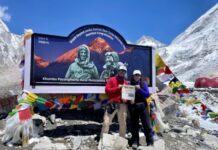Saunders Meadow has supported educational programs for the past 70 years, but its varied history reaches back far earlier than the 1940s. Thanks in part to recent research by my Idyllwild Area Historical Society colleague, Dr. Robert Reyes, a more complete story is emerging.
Space will allow me to sketch only a general outline. It begins with Cahuilla Indian bands, who escaped the desert heat each year with a sort of summer shopping trip for acorn meal and small game to enrich their sparse winter diet.
The first settlement on Saunders Meadow stemmed from the massive land grant Congress gave the Southern Pacific Railroad in 1871. First, this brought loggers into our mountains by 1875 to harvest timber for railroad ties and to fuel locomotives; then they used the lumber for Southern California’s construction boom, and finally wood for fruit crates.
Amasa Saunders was prominent among these early arrivals, although he had nothing to do with the meadow that memorializes his name. His sawmill was down on Strawberry Creek, his cabin on the present elementary school grounds.
Instead, it was lumber baron Anton Scherman who built and operated a sawmill on Saunders Meadow from 1882 to 1889.
When Scherman moved to Dutch Flat, the meadow got a quiet decade to recover. Then it became a welcome sight for horsemen, wagoneers and stagecoach passengers arriving from Hemet via Keen Camp (Mountain Center). This 1899 cutoff pioneered the path of today’s Saunders Meadow Road between school and transfer station.
The meadow became part of the 5,200 acres bought by Los Angeles developers Strong and Dickinson in 1906, but the land lining its uphill side remained within the national forest. (Saunders Meadow itself may already have been part of Scherman’s extensive land holdings when the original forest reserve was proclaimed in 1897.)
After Claudius Lee Emerson bought 1,000 acres of central Idyllwild from Strong and Dickinson in 1917, intense competition for potential buyers between their two development companies led in 1925 to creation of a golf course on Saunders Meadow.
With an elegant clubhouse and swimming pool added in 1927, the San Jacinto Mountain Golf Club competed favorably with Emerson’s Idyllwild Inn as a social center. Alas, it was a financial fiasco from the start, finally going bankrupt in 1930.
The Braunschweiger family that got the property dreamed of resurrecting the golf course. But they could do no more than keep the lodge open for social events until 1940, when Desert Sun School began leasing 40 acres for its summer camps. The school then bought the meadow in 1944 for its permanent, year-round campus.
Meanwhile, between 1897 and 1922, Congress in its wisdom had passed a series of laws to make national forests more “productive,” permitting private parties to exploit water sources, to lease lots for summer cabins and to trade land with the Forest Service. Thus, in 1924 the U.S. Forest Service began leasing 59 lots along the federal side of Saunders Meadow.
The new residents built cabins and created one of the first homeowners’ associations in the country, encouraged by USFS as an organized way to develop a water source, while minimizing vacationers’ impact on the forest. Eventually, when the USFS announced termination of the land lease program, the community pooled resources to buy private land they could exchange for title to their lots. This privatization was finally achieved in 1972.
Since 1990, Desert Sun School’s successor, Astrocamp, has spilled onto Saunders Meadow from one side while private residences line the other. Driving down Saunders Meadow Road to the dump, you might ponder the checkered past that has given way to this quiet green expanse.
Bob Smith is a researcher and archivist with the Idyllwild Area Historical Society. He welcomes comments, questions, corrections and suggested topics for this column at [email protected].










